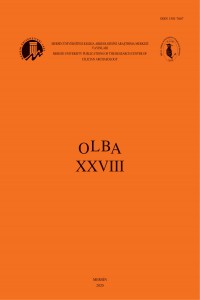A Group of One-Handled “Sardis Type” Amphorae from the Excavations at Küçükçekmece Lake Basin (Bathonea ?)
Öz
Küçükçekmece Lake, located in Avcılar district of Istanbul, hosted an important Late Roman-Early Byzantine settlement. Archaeological excavations in the Küçükçekmece Lake Basin (Bathonea ?) carried out on the west coast of Lake Küçükçekmece, have provided important discoveries of a harbor settlement located in the hinterland of Constantinople. In the "8th area”, a structure which is thought to be a νοσοκομεῖον (nosokomeion) and a space, related to the structure came to light. It appears that the space was destroyed by fire and that, in particular, objects in the building were fired. Amphorae, marble mortars, pestles, bone medicine boxes, glasses, spatulas and a large number of unguentaria were recovered inside the space. This paper presents a group of one-handled “Sardis Type” amphorae which were discovered in-situ in the space related to the structure. Amphorae and their contents have been examined morphologically and analogically. According to a morphological examination of the six amphorae found in Küçükçekmece, it is thought that they were produced at the same time and were departed from the same center. On the other hand, samples from other centers (Pyrgouthi, Sucidava, Tomis, Histria, Capidava, Caesarea, and Sardis) classified as belonging to “Sardis Type” amphorae were detected and they are outlined in the paper. By comparison with the clay structure and colours of all amphora samples, It seems that the clay characteristics of the samples (except Caesarea amphora) are very similar, and the colours of all the amphorae are very close to each other. In terms of form, the closest example to the Küçükçekmece amphorae is the Pyrgouthi sample. Besides that, the form of the Histria and Tomis amphorae is very close to the Küçükçekmece amphorae, and; the other samples have similar and comparable formal properties. The production site of the “Sardis Type” group is not yet known by archaeologists. The accepted idea is that the origin of the “Sardis Type” amphora group is in the territory of Sardis because of the clay resemblance. In this paper, a total of eighteen amphora samples are compared according to date and content of the amphorae. All of these amphorae were likely produced and used in the middle of the 6th – beginning/middle of the 7th c. A.D. It is not clear which product these amphorae were used to transport, but the assumption is that they were transporting wine because of the traces of resin found in an amphora from a well at Sardis. On the other hand, the possibility of unguent/lipid transporting is also crucial.
Anahtar Kelimeler
Kaynakça
- ‘Ad 2000 ’Ad, U., “Nahal Tanninim”, Hadashot Arkheologiyot: Excavations and Surveys in Israel 111, 39-41. Adan-Bayewitz 1986 Adan-Bayewitz, D., “The Pottery from the Late Byzantine Building and its Implications”, Excavations at Caesarea Maritima: 1975, 1976, 1979: Final Report (ed. L. I. Levine – E. Netzer), Jerusalem, 90-131. Atik – Özkılıç 2017 Atik, Ş. – Özkılıç, M., “Küçükçekmece Göl Havzası (Bathonea ?) Kazıları Geç Antik Dönem Cam Buluntuları”, İstanbul Küçükçekmece Göl Havzası Kazıları (Bathonea), İstanbul, 317-341. Atik 2018 Atik, Ş., Küçükçekmece Göl Havzası (Bathonea?) Buluntuları Işığında Sosyal Yaşam Kurguları, Bütün Yollar Avcılardan Geçer, 229-242.
Ayrıntılar
| Birincil Dil | İngilizce |
|---|---|
| Konular | Arkeoloji |
| Bölüm | Araştırma Makalesi |
| Yazarlar | |
| Yayımlanma Tarihi | 1 Mayıs 2020 |
| Yayımlandığı Sayı | Yıl 2020 Sayı: XXVIII |


